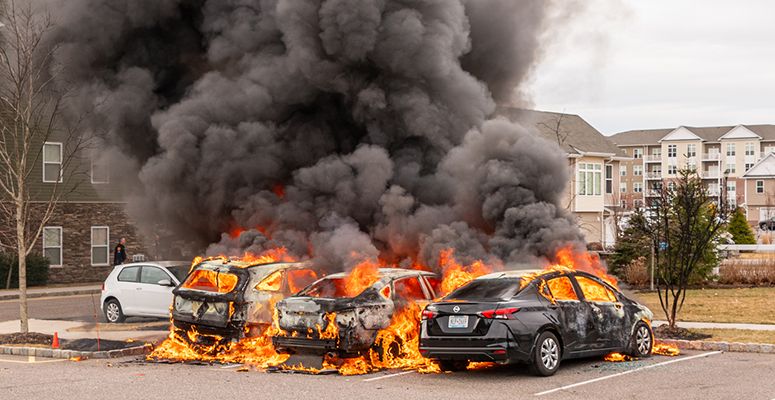Collateral Damages of Hard-to-extinguish Electric Cars

With the rise of electric vehicles all over the world, comes a great risk as well. Driving a car that is better for the environment is obviously great, but what happens when an electric vehicle catches fire? And why are EV car fires so dangerous to their surroundings? In this article, we tell you all about the collateral damages of EV fires.
Why are Electric Vehicle fires so hard to extinguish?
Even though EVs are less likely to catch fire than regular cars, when they do, the fire will be much more intense and very hard to extinguish. The key difference between extinguishing a traditional car fire and an EV fire lies in the lithium-ion battery. Most electric vehicle fires emerge when this battery is getting charged. When a cell of the battery overheats, it can enter a process that is called ‘Thermal Runaway’. The cells in the battery will keep overheating themselves very quickly, causing a fire and in some cases, an explosion. Because the battery cells keep accelerating, the EV car fire cannot simply be put out with water. It will take hours, maybe even days, to put out a fire like this with just water. And how longer it takes to put out the EV car fire, the more chance of collateral damage.
How to prevent Collateral Damages of Hard-to-extinguish Electric cars
When an EV catches fire, there is not much we can do to save the car itself. However, a very important aspect of fighting EV car fires is minimizing collateral damages as much as possible. When a fire occurs in an electric vehicle, there are often other cars parked near to them. For instance in parking lots or parking garages. To ensure the fire remains contained within a single vehicle, and not extend to adjacent cars, we came up with the Fire Isolator Concept.
Instead of trying to put out the fire immediately, Fire Isolator concentrates on isolating the fire first. This approach buys valuable time to safely move the vehicle to a secure location without risking harm to other vehicles or property. This method is particularly effective in situations like underground parking garages or on roro-ferries or car carriers, where a swift response is crucial to prevent widespread damage.

How to effectively isolate EV Car Fires with the Fire Isolator Concept
The Fire Isolator Concept integrates several proven elements that work in together to provide the most effective way to isolate EV car fires:
- A High-Temperature Resistant Car Fire Blanket: This fire-resistant blanket can withstand temperatures up to 1600 degrees Celsius, offering both isolation and control of the fire while preventing collateral damage.
- Potassium Aerosol Units interrupt the chemical chain reactions within flames and suppress the fire, leading to a significant reduction in temperature.
- A watermist lance to spray over the fire blanket to reduce toxic fumes and smoke, and to keep the car cooled.
- Thermal Imaging Camera: This tool aids responders in assessing the situation accurately.
- On land: a Dipping Container to submerge the EV car in for several days, if necessary.
- Proper training for effectively implementing the Fire Isolator Concept.
Proven Effectiveness & Safety Standards
Fire Isolator has undergone extensive testing by experts and dealers worldwide. On our video page, you can view videos of live tests that showcase its effectiveness.
Rest assured that the Fire Isolator Concept adheres to safety standards, with the Fire Blanket being tested according to ISO EN 13501-1 and the Aerosol Units being SNAP-listed by the EPA.
Protecting Surroundings for Collateral Damages
While we may not be able to save the vehicle itself, the Fire Isolator Concept ensures that the fire doesn’t get worse, containing it and preventing collateral damages of EV fires to the surrounding environment.
In the ever-evolving landscape of electric vehicles, addressing the challenges posed by lithium-ion battery fires is of utmost importance. Fire Isolator offers a proactive approach to limit collateral damages and enhance the safety of passengers, responders, and property alike.
When it comes to EV fire safety, isolation can be the key to preventing Collateral Damages of Hard-to-extinguish Electric Cars.

